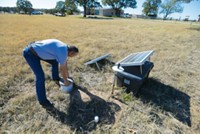Advertisement
Grab your lab coat. Let's get started
Welcome!
Welcome!
Create an account below to get 6 C&EN articles per month, receive newsletters and more - all free.
It seems this is your first time logging in online. Please enter the following information to continue.
As an ACS member you automatically get access to this site. All we need is few more details to create your reading experience.
Not you? Sign in with a different account.
Not you? Sign in with a different account.
ERROR 1
ERROR 1
ERROR 2
ERROR 2
ERROR 2
ERROR 2
ERROR 2
Password and Confirm password must match.
If you have an ACS member number, please enter it here so we can link this account to your membership. (optional)
ERROR 2
ACS values your privacy. By submitting your information, you are gaining access to C&EN and subscribing to our weekly newsletter. We use the information you provide to make your reading experience better, and we will never sell your data to third party members.
Environment
Shallow Fracking Wells May Threaten Aquifers
Environment: Analysis finds thousands of oil and gas hydraulic fracturing wells are less than a mile deep
by Jeff Johnson
July 31, 2015
Several thousand near-surface hydraulic fracturing, or fracking, operations for oil and natural gas production in the U.S. pose a potentially significant risk of contaminating drinking water sources, according to a new analysis. This first national assessment of fracking focused on well depth raises particular concerns about fracking wells less than a mile deep (Environ. Sci. Technol. 2015, DOI: 10.1021/acs.est.5b01228).

Fracking uses water, sand, and an often-proprietary blend of chemicals, which may include benzene, toluene, and other hydrocarbons. Oil and natural gas drilling companies force the mix underground under high pressure to fracture pockets of rock and release oil and gas trapped within, which they draw to the surface.
Shallow wells are cheaper and easier to operate, says Robert B. Jackson of Stanford University, who led the new study. “However, they pose a greater risk for groundwater contamination since they are close to drinking water aquifers.” These groundwater sources can rest from hundreds to thousands of feet below the surface, and natural geologic cracks or faults and past drilling activities can provide a pathway between shallow fracking sites and an aquifer, allowing fracking chemicals, oil, and methane to reach drinking water supplies. Currently, groundwater in Wyoming and California is being investigated for possible fracking-related contamination.
Jackson and colleagues sought to better understand how widespread the risks of fracking-related groundwater contamination might be. So they analyzed the best and only data on fracking wells drilled, from a mostly voluntary well-drilling reporting system known as FracFocus. Between 2010 and 2013, nearly 7,000, or 16%, of the 44,000 hydraulic-fractured oil and gas wells that companies reported drilling were less than a mile deep, according to the team’s analysis. At least 2,600 wells were fracked at 3,000 feet deep or less, and some as shallow as 100 feet. The median depth for all fracturing wells was around 8,200 feet.
In addition, when fracking at least 2,000 of these wells less than a mile deep, drillers used large amounts of water and chemicals, more than 1 million gal per well, to initially fracture rocks and free oil and gas reserves. This subset of wells presents even higher risks of groundwater contamination, the team reports. Arkansas, for example, had more than 300 wells fracked shallower than 3,000 feet, using an average of 5 million gal of water and chemicals per well.
FracFocus relied on voluntary reporting during the study period, and Jackson estimates that the actual number of wells drilled was at least twice the reported number. Reporting requirements have become more stringent since late 2013, however, says an official with FracFocus.
Because they are cheaper to drill, shallow wells are likely to become more common, Jackson notes. But because the output in fracked wells drops by about 80% within the first two years of production, tens of thousands of fracked wells would have to be drilled each year to maintain current output, he says.
Several countries, including Germany, the U.K., and Canada require, or are considering, regulation of shallow-well fracking to guard against groundwater contamination. In the U.S., only Texas and Colorado have any policy or technical requirements for such wells so far, according to the report.
Both Jackson and Mike Nickolaus, an analyst with the Groundwater Protection Council, an organization of state water regulators, found the number of shallow wells surprisingly high. But, “depth is not the only issue,” Nickolaus notes. The margins between well and aquifer and the makeup of rock, the site-specific geology, and fracking pressure are also important. He adds that several states are considering measures that would mandate site-specific studies before drilling begins as well as groundwater monitoring before and after fracking near drinking water sources.




Join the conversation
Contact the reporter
Submit a Letter to the Editor for publication
Engage with us on Twitter